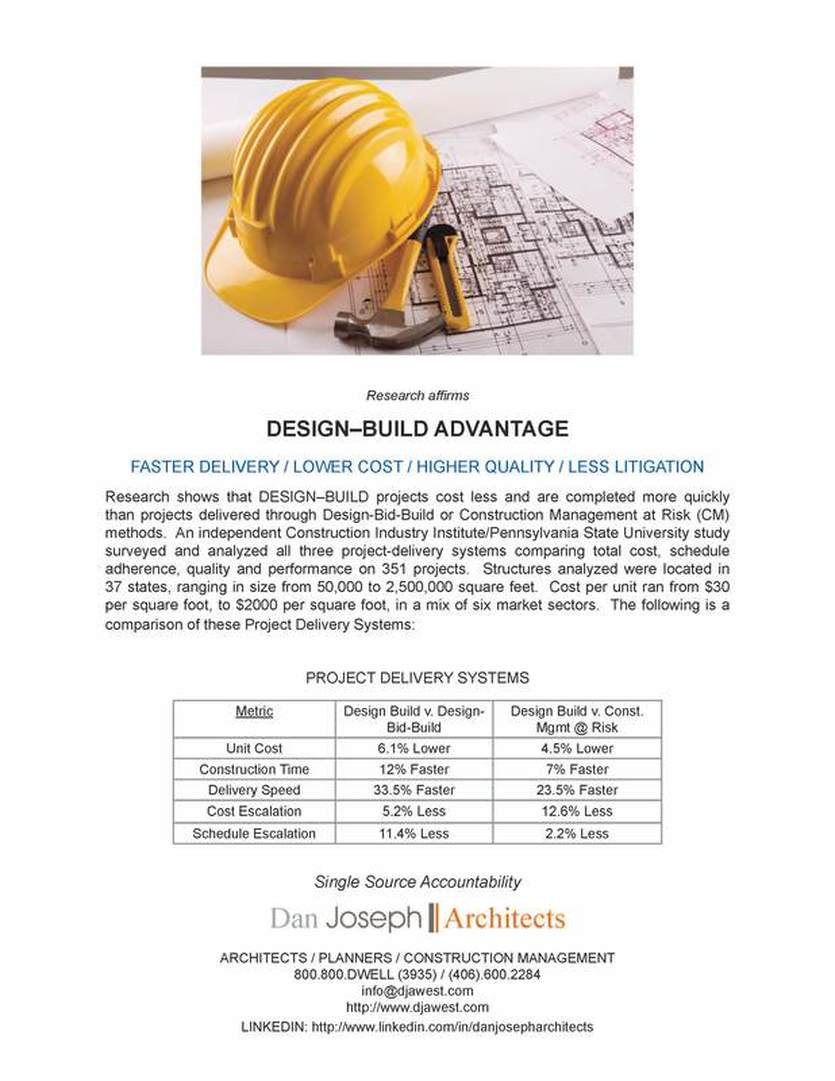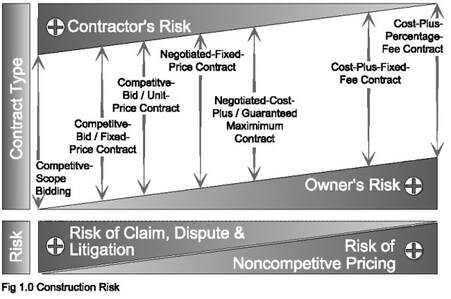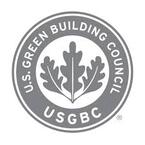It's in Our Blog
|
Moose Lake Lodge / Dan Joseph Architects
Yellowstone Club, Big Sky Montana |
|
Moose Lake Lodge / Dan Joseph Architects
Yellowstone Club, Big Sky Montana |
 Think Design / Build Dan Joseph Architects Construction delivery is changing before our very eyes. Design–Build previously known as just another option to the built solution may now be the most preferred method of the built response. The old method in the separation of design and construction is not the standard in many other more complex and cost driven industries. Why then has there been a separation in building design and the construction process? Well, formally and until just forty years ago, the American Institute of Architects (AIA) suggested that architects should remain detached from the actual construction process of any project, including design-build project delivery. Now repealed, owners are now choosing design-build for a number of good reasons including: Single Source for Design and Construction, Quicker Project Delivery, Guaranteed Project Pricing, Minimized Claims and Damages, Extended Product Warranties. Further, Design-Build keeps the appropriate stake holders involved in the process from concept to turn-key, by formally integrating all entities into a simplified contractual agreement of “Single Source Accountability.” ARE ALL ARCHITECTS CAPABLE OF PROVIDING SINGLE SOURCE DELIVERY SERVICES? The standard prerequisite is experience, capacity and diligence; therefore it is fair to say that not all Architects are equal in delivering a Design-Build service. However, the risk of taking on a professional practitioner that lacks experience in the built response can be greatly diminished by insisting that the Architect pre-qualify and collaborate with a well respected and capable Construction Manager. WHAT QUALIFIES A CONSTRUCTION MANAGER AS CAPABLE? As in any endeavor a successful track record over a number of years is an important benchmark; but no less important is the utilization of a proven process and the comprehension to a number of related topics including: Costing of Preliminary Design, Design Development and the final Construction Document (Uniformat, WBS, Master Format), including Request for Information (RFI’s), General Conditions, Allowances, Equipment Rentals, Estimated Costs, Solicitation of Bids (RFP’s), Self Performance, Cost Plus Work (T&M), Pay Applications, Change Orders, Wavier of Liens, Sworn Statements, Project Scheduling, On Site Supervision, Safety Program, Owner Review Documentation-Disclosures, Insurance, Bonding Capacity and other similar relevant matters. VERIFY, VERIFY, VERIFY Long gone are the days of Cost Plus Services (commonly known as Time & Material Agreements), when it was sufficient to enumerate a list of activities that equaled an owner proposed budget. Project expenditures can equal millions of dollars and each listed item of service or expense must be verifiable in both quantity and unit cost modified to equal regional norms. Believe it or not there are still some contractors in the industry that will start with a proposed budget under a “Cost Plus” and will quickly allocate by percentage to multiple pages of cost, with no verifiable means in which to support the data of expense shared. Simply stated, if the line item is not quantified, it is not valid, should be held as suspect and is likely erroneous! Engaging a process that is not verifiable results in one of two outcomes; the first is in the proclamation that the final cost is under the overall budget. Such a declaration is meaningless; with some diligence in review, it will be revealed that while some line items are much less then anticipated, many more are over….either way the owner will likely have paid much more then the value of the total work provided in a game of pushing numbers to match an inflated, unverified, misrepresentation of expenditure. The second possible outcome of an unverified process of project delivery is a long parade of Requests for Change Orders. Change Orders can either be for deductions (reduced scope of work, substitution of means, methods or materials), or for adds. The emphasis here is Change Order Adds or a Request for Change Orders that inflate the final contract amount. If the unverified sum proposed is undervalued, say due to an error of not pumping the number high enough for a safe outcome, the result will be in the form of a dreaded Change Order. So take note…predictable project expenditures will require consistent, verifiable means of back checking; and in the absence of quantifiable measures, your final project cost will most certainly exceed your expectations. (Please note that some Change Order Adds are legitimate, such as: Owner driven requests for change, unknown below surface conditions, missing detail, etc. and will not be expanded upon during this brief discussion.) THE PERFECT STORM By example here is one scenario that you should avoid at all costs. The contractor is charming, energetic, articulate, they also appear to be competent and have completed a few projects in the area; in fact they may have even been introduced by an acquaintance or friend that was introduced to the contractor in the same unsuspecting manner. Accomplishments are often times exaggerated, as they confidently offer to cost out your project. Within a few days or sooner they will have quickly presented you with an estimate, likely well before any other reputable contractor and at a price that appears to be competitive. Interested, you invite them back for another discussion. During this meeting you may feel a little rushed; as the contractor talks about pending weather, a backlog of work or perhaps that labor and material pricing is at an all time low…”now’s the time to act” you are told. During your discussion a budget that appears very well organized and detailed, over many categories and a number of pages is pushed across the table. In your review it appears to all be all accounted for, plainly stated and best of all the contractor has offered to perform this work on a cost plus basis. Cost Plus you are told is by where all work is completed for the submitted cost and a reasonable margin will be added to the bill later for overhead and profit. You talk about the margin of mark-up and settle on a percentage that works well for both parties. During this meeting or perhaps later on you are presented with an agreement where the basis of payment is "Cost of the Work" plus a fee and there is no “Guarantee of Cost”. Wow what a deal…you are only going to pay for cost and a small margin of mark-up to oversee your project! At this point you willingly sign the agreement, pay the deposit and work commences. However upon the first pay request some of the costs have been exceeded and suddenly you are confronted with requests for Change Orders (a formal document that inflates the contract sum). After several months into construction a pattern of busting budgets and requesting change orders is well established. You are told that while some items have exceeded expectations, many others are under and the in the end it will all even out. You aren’t happy, but you feel stuck…what can you do; you’ve got to finish the project? If you pull the plug now, it becomes just a heap of uncompleted work; you will loose momentum, be distracted from your work and will end up with yet a larger headache. You decide to bite the bullet and sign off on the change orders. Truth be told…far too many good natured and unsuspecting home owners have been down this bumpy road. But what can you do, how do you build the home of your dreams for a fair and predicable price? Here is some practical advice… First, I highly recommend that large scopes of work be delivered under a Design-Build enterprise; dollars will be maximized under this arrangement and allows you to be in control of the project every step of the way. Next, if you are determined to work under a separate agreement for the built solution, have several reputable, competent and capable contractors competitively bid the project…per plans and specifications, under a Lump Sum–Fixed Fee Agreement. The price will be competitive, is guaranteed and change orders will be less frequent. Lastly…if you are determined to work under a Cost Plus arrangement be forewarned… Under a Cost Plus agreement profit incentives invite the following: Less on-site management (reduced overhead for the contractor, more cost to you, shoddy workmanship, mistakes), a buddy system of sub-trade selection (higher pricing, inappropriate gifts or referral fees, no competition), delayed and extended schedules (padding down time between projects, increasing profits, working on other projects), requests for multiple change orders (costs exceeding a poorly estimated and managed project expense), work performed is on your clock not theirs (dramatically increasing labor costs, hiring of incompetent craftsman, inaccurate or false reporting of time, material, equipment, etc.), increased cost of equipment rentals (the longer the equipment is on site the more margin paid the contractor)…the list goes on and on and on. At the very least…if you are going to move forward under a Cost Plus arrangement despite the many pitfalls and disadvantages, require the following: i.) That each itemized line of expense be supported with “units of measure” (cubic yards, square foot, tons, board feet, per item, allowance, man-days, etc) and the “price per unit”, that can be compared to the architects take-off and other competing contractors estimates. Remember…in the absence of these “units”, the estimate and thus the proposal or agreement is bogus! ii.) After confirming all units of measure to the plans, estimates, etc. approve of the amount(s) as an “NTX” or a “Not to Exceed” only. In other words the amount noted is the cap…approval is not granted for sums exceeding this amount. However, this arrangement will not guarantee you a price that will be less then the sum proposed; and in fact will likely equal or exceed the amount noted in the desire to earn all available sums within grasp of the contractor. iii.) Be leery of work self performed by a contractor that can be competitively bid for less by outside sub-trades. iv.) Watch for material, finishes, or equipment, etc. substitutions that reduce the cost that are not translated into a savings for you or the project; but rather improve the contractor’s margin of profit only. e.g.: windows, flooring, hardware, roofing, furnaces, etc., etc. Wrapping up…many contractors are reputable, honest and deserving of praise and sums paid for their service; this example has been provided in the attempt to help the unsuspecting from becoming victims of tactics by dishonest business practices known to exist in the market place. CONCLUSION With decades of construction specific and professional service experience, Dan Joseph Architects is ready to assist with your project needs. We have prepared a list of pre-qualified contractors and continue to interview, audit process and capacity to meet the growing list of tomorrows demand. Give us a call and discover the joys and the many advantages of a Design-Build Team for your next project! POINTS TO REMEMBER 1. A Design-Build relationship keeps all stake holders actively involved as “Single Source” accountable from concept to completion. 2. Not all architects are capable of delivering an effective Design-Build service; qualify experience, capacity and diligence. 3. Design Build is the most competitive, timely project delivery system known, as supported by intensive study. 4. When selecting a Contractor, a successful track record over a number of years is an important benchmark; but no less important is the utilization of a proven process and the comprehension to a wide range of related topics. 5. Most importantly…predictable project expenditures require consistent, verifiable means of back checking; and in the absence of quantifiable measures, your final project cost will most certainly exceed your expectations! 6. Stay away from “Cost Plus” agreements for large scoped projects. https://www.djawest.com/contact.html  Owner's Risk Often times I am approached by friends and prospective clients that are in need of explanation, direction or supplemental information on how best to engage a contractor. While this topic is much more inclusive than what can be shared within this brief informational, the graph above will help to assist with understanding risks involved relative to the Construction Contract selected. Basically, different types of construction contracts can be sub-divided into two large groups. One group includes those contracts for which the owner selects a contractor based upon competitive bidding; the other in which the owner negotiates a contract directly with the contractor. Summarizing, a competitive environment fosters the best price and an efficient construction schedule. Risk of claim or a dispute can be greatly diminished by issuing comprehensive supplemental conditions and by understanding how to control other associated project costs not well defined by the construction documents: weather protection, below grade obstructions, utilities, allowances, and owner driven change orders or extras. As always, Dan Joseph Architects is available to assist you with understanding the many options possible, implications and risk associated with any preferred method, including: Lump Sums, Unit Price, Competitive Bid, Special Reimbursable, Contractor Fees, Cost Plus-Percentage of Cost, Cost Plus-Fixed, Incentive Fee Contracts, Guaranteed Maximum Price and Design Build. COMMON METHODS OF CONTRACTOR SELECTION Competitive Bidding - By where Contractors have been pre-qualified based upon experience, reputation and capacity to serve; award would go to the "lowest responsible bidder" qualified to complete the job in accordance with the terms of the contract. Negotiated Contract - By where a Contractor has been hand picked based upon experience, reputation and capacity to serve; candidate is assumed to be qualified to complete the job in accordance with the terms of the contract. Cost Plus Fee Contract - Contracts of the cost-plus-fee variety are used where, in the judgment of the owner, a fixed-sum contract is undesirable or inappropriate. Cost-plus contracts are normally negotiated between the owner and the contractor. Most cost-plus contracts are open ended in the sense that the total construction cost to the owner cannot be known until completion of the project. Cost Plus or Time and Material agreements should be thought of as "on the clock" arrangements that if used exclusively, may reduce the incentive to manage closely the work at large, resulting in inflated budgets, unexpected cost(s) and extended schedules. However, when used in conjunction with Competitive Bid Contracts, there are benefits to limited hourly tasking that at times will prove to be useful for managing project cost. POINTS TO REMEMBER: 1. Competition fosters the best price and a timely completion of your project. 2. Limit disputes by making sure that your architect issues Supplementary Conditions with the Bid Set for items not well defined in the General Conditions: weather protection, below grade obstructions, utilities, allowances, supervision, clean up, dumpsters, schedules, equipment rentals, other responsibilities, insurances requirements, safety programs, RFI’s, etc., along with owner driven change orders (adds & deducts). 3. Understand the common methods of Contractor Selection and the attached graph for implications. https://www.djawest.com/contact.html  Project Concept Dan Joseph Architects The works of Dan Joseph Architects stands as a responsible approach to historic interpretation of western dwellings. His energy conscious designs combine a love of form, local materials, structural expressiveness and nature, defining a style that becomes as much of the surrounding landscape as does the dramatic views surrounding his practical solutions. At a very basic level the Art of Architecture is often about stirring imagination, interest and excitement; to incorporate a twist of curiosity while seeking a new plane of creativity, says Turvey. “My method has been to consider the arts, literature, music, science and history…inspiring a unique architectural response to a perceived or shared need.” A book later turned movie titled “Cowboys & Aliens” featuring Daniel Craig and Harrison Ford has generated inspiration and an exciting new approach for a modern western vernacular. However the movie or story line isn’t so much a source of motivation, says Turvey...but rather the title. For Dan the title “Cowboys & Alien” suggests organic, with site specific queues which are firmly rooted in a western past; while also embracing cutting edge, modern materials and expressions...perhaps best termed as a “Modern Western”. Dan suggests that it may be helpful to alternatively think about the blending of other extremes like music i.e.: Rock-n-Roll and Country or for instance Mannheim Steamroller’s best selling Christmas melodies; a body of work we all recognize as traditional, holiday standards, which utilize a modern vibe and distinct instrumentation. “Likewise and in the visual world, a Modern Western is about creating a new appearance informed by nature, our past, expressed, mixed and supplemented with a futuristic vision” says Turvey. To infuse this original concept with momentum and notable, significant credibility, Dan has obtained commitments from Cowboys & Aliens co-author Andrew Foley and famed graphic artist Dennis Calero (see pic above) to join Dan Joseph Architects in a collaborative exploration of what it means to be both Cowboy & Alien; or moreover a Modern Western. There is no doubt, says Turvey “that the work product generated by this outstanding team will be worthy of much attention.” Certainly, this one-of-a-kind collaborative must be informed by site specific solutions and buyer directives; therefore Dan Joseph Architects welcomes a progressive owner, directing personal preferences of final character, project budgeting and schedule. Cowboys and Aliens Project Concept inquires are encouraged to contact Dan Joseph Architects with any questions or to just simply talk more in depth on the themed project shared. In closing...Cowboys and Aliens is perhaps the best contemporary Western Movie ever made; the actors are credible, authentic and unforgettable. The various scenes demonstrate the importance of perception, perspective, time and place woven within the fabric of a modern story line captured at its very best moments; the music is appropriate and moving...supporting a theme that gently nudges the viewer backwards in time, when life was simple and valor most admired. https://www.djawest.com/contact.html http://en.wikipedia.org/wiki/Cowboys_%26_Aliens http://en.wikipedia.org/wiki/Andrew_Foley_(writer) http://en.wikipedia.org/wiki/Dennis_Calero  Snap Shop of USGBC Certification - Dan Joseph Architects The built response has a significant impact on our quality of life, the natural world, health, economy and productivity. Consistently, new building means and methods, technologies and equipment are available to Architects and Owners alike who want to build in a responsible manner; benefiting from economic and environmental performance. The US Green Building Council utilizing a LEED (Leadership in Energy and Environmental Design) Certification program has rapidly transformed the old way of building structures into a celebration of performance based achievement. Through a process of third-party verification, a long list of completed tasks are assigned a point value that upon tabulation, will recognize the structure as either Certified, Silver, Gold or the highest achievement Platinum. Credits towards certification are earned in each of the following categories: Sustainable Sites, Water Efficiency, Energy and Atmosphere, Materials and Resources, Indoor Environmental Quality, Innovative Design, and others depending on your building use and designation. THE PROCESS So exactly what is the next step for those desiring LEED Certification? It actually begins with a commitment from the owner; in the big picture of things the owner makes all things possible. Next…your architect needs to think critically while delivering good passive techniques, planning and design for high performance standards. No less important are the buildings support systems, including state-of-the-art HVAC, lighting, controls and other technologies that will improve the performance of your structure. Concurrently and during the design phase of service, your architect will assist you with the selection and engagement of a Certified LEED Consultant or Provider. Providers play a very important role in the over-all process, which unfortunately at times are quickly forgotten upon making the mark. As third-party verifiers, it is very important that the Provider be contractually accountable to the owner only, not the architect or contractor; allowing for unbiased reviews of the completed work that will be documented and shared with the owner and the USGBC. Additionally, Providers offer over the shoulder review of evolving design and later contribute critical direction during the construction process. Lastly, your contractor must competently execute the plans and the various lists of assignments required to successfully meet the objectives. It is important to note that registration, use and access of the “Final Check List” are controlled by the owner; again…not the contractor, architect or even the USGBC; so make sure that the final registration is in the owner's name exclusively. CONCLUSION While it is easy to over-simplify the process, achieving LEED Certification is a commitment whose thread can be traced from concept to completion, requiring months or years of diligence. As we move towards Net-Zero Buildings, the USGBC–LEED program has cleared a path for sustainable practice and continued reform for much of the built environment. Utilizing LEED criteria, energy codes and modern building efficiency standards, Dan Joseph Architects is ready to assist you with LEED Certification. Give us a call… POINTS TO REMEMBER 1. Construction means and methods, technologies and equipment are constantly being updated. 2. LEED Certification for new projects is available through a process of third-party verification of completed tasks. 3. Your architect needs to think critically while delivering good passive techniques, planning and design for high performance standards. 4. As third-party verifiers, it is very important that the Provider be contractually accountable to the owner only, not the architect or contractor. 5. Contractors must competently execute plans and the various lists of assignments required to successfully meet objectives. 6. Registration, use and access of the “Final Check List” are controlled by the owner…not the contractor, architect or even the USGBC; so make sure that the final registration is in the owner's name exclusively. 7. The USGBC–LEED program has cleared a path for sustainable practice and continued reform for much of the built environment. https://www.djawest.com/contact.html http://www.usgbc.org/ |
AuthorDaniel Joseph Turvey, AIA
Award Winning Architect & Construction Adminitrator Archives
January 2023
Categories |